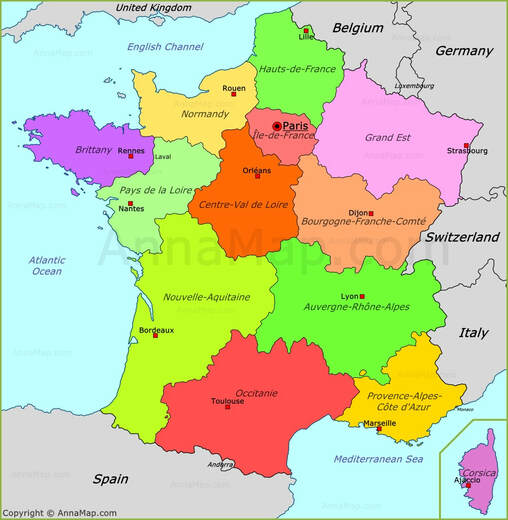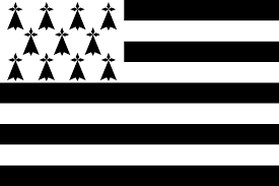Brittany (Breizh)
|
Brittany, located in the northwest of France, is the homeland of the Breton people. During the Roman occupation the region was called Armorica. Brittany united with the Kingdom of France in 1532. The region is bordered by the English Channel to the north, the Celtic Sea and the Atlantic Ocean to the west, and the Bay of Biscay to the south. Its land area is 13,136 sq. miles.
Modern day Brittany has a population of about 4.5 million. Roughly 356,000 (8% of the population) claim to have some skill in the Brittonic language native to Brittany. In terms of production, Brittany is the #1 agricultural region and #1 fishing region in France. |

The Breton language is related to Cornish and Welsh. Cultural ties to Ireland and Wales date back to the first millennium.
The harp dominated Breton music in the medieval period. The instrument is known as the telenn in Brittany. In Wales the harp is called the telyn. The harp tradition faded during the Baroque period, but was revived in the 1950s.
The dance tradition of Brittany includes the Gavotte and the Ridee. The Gavotte is a piece in 4/4 time. The Ridee (rah – DAY) is often mistaken by non-Breton musicians for a waltz and is often incorrectly written in ¾ time. A ridee tune is played as a series of six eighth notes that are grouped in pairs. One measure of a ridee and one measure of a jig both contain six eighth notes. But the jig plays those six notes in groups of three. Jig music is usually noted in 6|8 time. Whereas a ridee plays those six notes in three groups of two. Ridee dance music is notated in 6|4 time. The notation device of 6|4 suggests that the music could be a waltz. Ridee is not waltz. Watch the performance video below to get the feel of a ridee.
The instrumental tradition of Brittany includes the use of the bombard. The bombard is a double reed instrument something like an oboe. The bombard is part of the shawn family of instruments. It sounds something like a bagpipe chanter without the drones. Bombards are loud instruments! To hear the bombard played in a Breton tune, listen to the performance link for Son ar Rost. Ealier ensembles often employed a call-and-response style of performance that included a bombard and a single-drone, mouth-blown bagpipe called the biniou koz
Bagpipes play a large role in Breton music. The biniou is somewhat of a musical symbol for Brittany. Ensembles using include the biniou and drums.
Other instruments within the Breton tradition include the treujenn-gaol (cabbage stalk), and the hurdy-gurdy. The treujenn-gaol is somewhat similar to a modern clarinet, but with fewer keys. The hurdy-gurdy is a keyed lute played by turning a wheel that bows strings.
Brittany has a unique form of traditional vocal music called kan ha diskan. This is a call-and-response vocal performance usually done by two singers. Typically phrases overlay between the two singers.
Brenton music is resurgent. During the 1600s church authorities sought to eliminate dancing. That in turn suppressed music. Church depictions of musicians depicted them as Satanic agents: "cloven-hooved beasts". In post-WWII Brittany dance returned to popularity and has been a vital cultural force ever since.
Brittany is, at times, called Little Britain. A nationalist movement within Brittany seeks greater autonomy within the French Republic.
For more information about Brittany explore these links:
www.gitelink.com/brittany/brittany-celtic-tradition.htm
https://en.wikipedia.org/wiki/Brittany
The harp dominated Breton music in the medieval period. The instrument is known as the telenn in Brittany. In Wales the harp is called the telyn. The harp tradition faded during the Baroque period, but was revived in the 1950s.
The dance tradition of Brittany includes the Gavotte and the Ridee. The Gavotte is a piece in 4/4 time. The Ridee (rah – DAY) is often mistaken by non-Breton musicians for a waltz and is often incorrectly written in ¾ time. A ridee tune is played as a series of six eighth notes that are grouped in pairs. One measure of a ridee and one measure of a jig both contain six eighth notes. But the jig plays those six notes in groups of three. Jig music is usually noted in 6|8 time. Whereas a ridee plays those six notes in three groups of two. Ridee dance music is notated in 6|4 time. The notation device of 6|4 suggests that the music could be a waltz. Ridee is not waltz. Watch the performance video below to get the feel of a ridee.
The instrumental tradition of Brittany includes the use of the bombard. The bombard is a double reed instrument something like an oboe. The bombard is part of the shawn family of instruments. It sounds something like a bagpipe chanter without the drones. Bombards are loud instruments! To hear the bombard played in a Breton tune, listen to the performance link for Son ar Rost. Ealier ensembles often employed a call-and-response style of performance that included a bombard and a single-drone, mouth-blown bagpipe called the biniou koz
Bagpipes play a large role in Breton music. The biniou is somewhat of a musical symbol for Brittany. Ensembles using include the biniou and drums.
Other instruments within the Breton tradition include the treujenn-gaol (cabbage stalk), and the hurdy-gurdy. The treujenn-gaol is somewhat similar to a modern clarinet, but with fewer keys. The hurdy-gurdy is a keyed lute played by turning a wheel that bows strings.
Brittany has a unique form of traditional vocal music called kan ha diskan. This is a call-and-response vocal performance usually done by two singers. Typically phrases overlay between the two singers.
Brenton music is resurgent. During the 1600s church authorities sought to eliminate dancing. That in turn suppressed music. Church depictions of musicians depicted them as Satanic agents: "cloven-hooved beasts". In post-WWII Brittany dance returned to popularity and has been a vital cultural force ever since.
Brittany is, at times, called Little Britain. A nationalist movement within Brittany seeks greater autonomy within the French Republic.
For more information about Brittany explore these links:
www.gitelink.com/brittany/brittany-celtic-tradition.htm
https://en.wikipedia.org/wiki/Brittany
The Breton tunes below are presented in both standard notation and ABC notation. Click on the audio players to hear the tunes. If you want to download an mp3 file of a tune to study it in greater depth, go to the tune download page.
Performance examples of Breton music can be found at this link
Sets from Brittany
| |||||||||||||
In the Breton Ridee Set take care to note that the time signature changed from 6|4 in the first part to 3|4 in the second part.
The tempo is 120 bpm in both tunes.
Tunes from Brittany
|
| ||||||||||||||
|
| ||||||||||||
|
|
| ||||||||||||||||||||||||||||||||||||
More Tunes From Brittany Can be Downloaded from this site:
http://www.celticscores.com/origin/Brittany/
http://www.celticscores.com/origin/Brittany/
